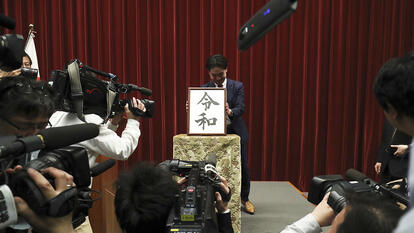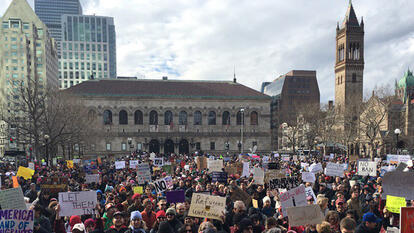
Wellesley College Theatre Presents a New Adaptation of Science Fiction Play “R.U.R.”
Before Karel Čapek’s science fiction play R.U.R., which stands for Rossum’s Universal Robots, debuted at the National Theatre in Prague in 1921, the word “robot” did not exist. Though words such as “automaton” and “android” could be found in many languages, they failed to capture the eerie similarities the artificial workers in Čapek’s play shared with humans. His brother, Josef, suggested he call them “robots,” after the Czech word for forced laborer.
Čapek’s skepticism toward utopian notions of technology resonated with audiences who had witnessed the rise of mass production after World War I. The play was quickly translated into English and had its Broadway premiere in 1922.
The Barnswallows, a dramatics society organized at Wellesley in 1896, staged the College’s first production of R.U.R. in fall 1934. This week, Wellesley College Theatre presents a new adaptation of the play directed by Marta Rainer ’98, director of theatre and theatre studies and senior lecturer in the department.
Wellesley’s Ruth Nagel Jones Black Box Theatre has been transformed into a secret factory, owned by Rossum’s Universal Robots, on a remote island. Rainer’s adaptation takes place in 2000, which Čapek considered “the future” at the time he wrote the play, and the movement of the geometric sets evokes the emerging technology of the period. The hope is that when audience members enter the theatre, they will feel as isolated from the rest of the world as the characters do.
The production is the culmination of THST 345: Practicum–Theatre Production, co-taught by Rainer and David Towlun, theatre production manager. Students in the course collaborate on performance and design elements to bring R.U.R. to life on stage.
Rossum’s Universal Robots manufactures millions of highly efficient humanoid robots that love nothing and have no will of their own. When Helena Glory, president of the League of Humanity, arrives at the factory, her goal is to protect the robots and ensure they are treated well, like people, which leads to a debate among the characters in the play about what impact the relentless pursuit of technological advancement might have on humanity.
Čapek considers how we can balance idealism and realism, and he reminds us to be careful not to lose touch with reality, but I think he also reminds us that it’s possible to remain hopeful as our role within the world changes.
Jiayi Shao ’27
Rainer says she decided to produce R.U.R. to continue the discussions about ethical approaches to technology that are taking place at Wellesley.
“When I was looking for a play to do, I thought a lot about the conversations we’re having on campus about AI and evolving technologies,” Rainer says. “I also thought about the movie-making industry in America and the [Writers Guild of America and Screen Actors Guild] strikes that relate to these conversations about technology in certain ways.”
Act I takes place a decade later than the Prologue. A revolution is underway, and robots far outnumber human beings. Will the remaining humans survive, or will the robots destroy them?
“It was really exciting to think about working on a piece written in 1920 before so much of the technology we’re talking about today existed,” Rainer says. “It was more theoretical then, and now we’re seeing how it’s being played out in reality. I just found that tension to be so interesting to explore.”
Yihan Ling ’27 plays Mr. Alquist, a builder and the chief of construction at Rossum’s Universal Robots. A potential data science and political science double major, Ling says the play’s discussion of ethical dilemmas in technology interested her.
While preparing for her audition, Ling read an article about her character that criticized him for being too dramatic. “I disagreed with that point immediately even though I didn’t know I would play him,” she says. “Alquist does have many dramatic moments in the show … but I completely understand why his anxiety increases year after year about robot production and the future of humanity.”
This past summer, Rainer went to Prague to prepare for the play. At the city’s National Theatre, she saw the set designs and playbill from the original 1921 production and visited the villa Čapek and Josef shared in a neighborhood west of the Vltava River.
“At the gate, there was a little note that said something like, ‘Call this number if you want honey.’ … I thought there was something really beautiful and interesting about that detail because it shows the longevity of the garden,” Rainer says. “These bees are making honey on the same property where these great minds were thinking, and it made me think about the triumph of nature over technology. So, I must confess that I infused that idea into the script a little bit.”
Rainer also went to Żyrardów, Poland, her mother’s hometown, as part of her research. There, she toured the Muzeum Lniarstwa (Museum of Linen), housed in a former linen factory.
“Part of my research involved trying to figure out a time that the play takes place in, since ‘the future’ is kind of vague,” Rainer says. “It was really moving to see the kinds of machines used by people who were really devoted to making this beautiful material … I took lots of pictures.”
Those pictures inspired Akasha Brahmbhatt ’25, the set designer of R.U.R. “Professor Rainer took many amazing photos of architecture and museums that I became obsessed with at the beginning of the design process … the set has many similarities to the photos I kept returning to,” she says.
Brahmbhatt says she and Rainer were also inspired by 1950s sci-fi comics and Czech Cubism.
“I took any opportunity I could to draw from many different periods,” Brahmbhatt says. “I also wanted to mix some aesthetics to convey that the fear of AI and robots taking over has been felt since the 1920s.”
“We looked at comic books from around the 1950s when the atomic race was happening, and a lot of that was playing out in sci-fi,” Rainer says. “The boldness of the colors and the gestures and the grandeur of the thinking really inspired a lot of us, so that has been something of a unifying vision.”
Jiayi Shao ’27 plays Dr. Hallemeier, head of the Institute for Robot Education and Psychology. At first, Shao says, she questioned why the robots would need a psychologist. After writing a biography for her character, an assignment Rainer devised, she says she better understood her role.
“The play places a lot of emphasis on the distinction between humans and robots because, in this setting, robots are just meant to substitute for human labor so that humans are free from working 9 to 5 and can just enjoy life,” Shao says. “Computers didn’t exist back then, meaning the robots can’t be programmed. So my character teaches the robots how to act human and how to replace human labor. He’s also there to remind the other characters, with a bit of humor, that maybe things aren’t so bad.”
Ultimately, Shao says, the play’s underlying message of hope resonates the most with her. “Čapek considers how we can balance idealism and realism, and he reminds us to be careful not to lose touch with reality, but I think he also reminds us that it’s possible to remain hopeful as our role within the world changes,” she says. “Even in the middle of a robot apocalypse, my character really values community, and he’s able to take a step back and appreciate the beauty that still exists in the world.”
Rainer says she hopes audiences will reflect on the play’s fundamental questions. “What does it mean to be human? What in essence defines—or proves—the human experience?” Rainer asks. “As some of the characters in R.U.R. ask: ‘What are we for?’”
Wellesley’s production of R.U.R. will take place December 7 to 10. To reserve tickets, click here.



